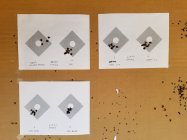Ned Ludd
Silver $$ Contributor
You are not alone in observing that CFE223 can sometimes produce unacceptably high ES/SD values. It is a double base ball powder, which sometimes do yield markedly more velocity than their single base counterparts. However, velocity is not everything, and the extra velocity obtained using double base powders sometimes comes with additional concerns such as high ES/SD and/or very abrupt transition into over-pressure as the ambient temp increases.
If it were me, I would also follow the plan you suggested and try H4895, or re-visit Varget. I have had very good results with H4895 under 168 Hybrids. I would also suggest narrowing down the number of variables in your tests. If you continue testing across such a wide range of variables using 10-shot groups, you might burn out your barrel by the time you find an acceptable set of components. I have always obtained satisfactory results using straight Fed210s (i.e. not 210Ms). As has been noted, the ES/SD values obtained using 5-shot groups can often suffer from small sample size issues. Nonetheless, increasing sample size to 10 shots will burn out a barrel faster and cost quite a bit more $$$ in terms of components and time. Is that really worth it when you can always run a 20-shot string to "validate" what you believe to be a finalized load once the development process has been completed? I agree that using the smaller sample size can sometimes be frustrating or even misleading in terms of ES/SD. However, people have been developing highly successful loads using such an approach for a long, long time, so it obviously can work.
If it were me, I would also follow the plan you suggested and try H4895, or re-visit Varget. I have had very good results with H4895 under 168 Hybrids. I would also suggest narrowing down the number of variables in your tests. If you continue testing across such a wide range of variables using 10-shot groups, you might burn out your barrel by the time you find an acceptable set of components. I have always obtained satisfactory results using straight Fed210s (i.e. not 210Ms). As has been noted, the ES/SD values obtained using 5-shot groups can often suffer from small sample size issues. Nonetheless, increasing sample size to 10 shots will burn out a barrel faster and cost quite a bit more $$$ in terms of components and time. Is that really worth it when you can always run a 20-shot string to "validate" what you believe to be a finalized load once the development process has been completed? I agree that using the smaller sample size can sometimes be frustrating or even misleading in terms of ES/SD. However, people have been developing highly successful loads using such an approach for a long, long time, so it obviously can work.











